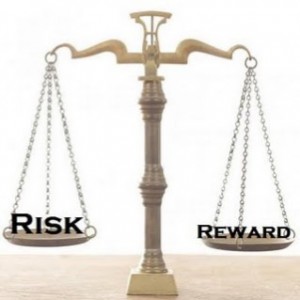Many of you have pensions or investments and know well the potential benefits and dangers of increasing your risk profile. But how many of you make similar judgments regarding risks when it comes to communicating?
We work with many firms helping them pitch and sell, both advising directly on specific transactions and running workshops and 1-1 sessions. We find ourselves advising our clients regularly to be more daring in both what they say and how they present their pitch.
In a world where few firms are brave enough to challenge the pre-conceived perceptions of how pitching and selling is done, being able to differentiate yourself positively is a powerful message in itself that can help you stand out for all the right reasons.
Taking risks should have rewards:
Why are so many of us afraid to take these types of risks? There are, it seems, two primary reasons. Firstly, there is simple loss aversion. As has been demonstrated scientifically, the psychological drive to avoid a loss is greater than the drive to achieve a gain1– hence, the majority of us have a natural tendency to ‘play it safe’ in these circumstances, intuitively believing it is the best thing to do.
Secondly, cultural (with a small c) factors influence us. From our schooling all the way up to our current corporate world, we exist largely in an environment where we are expected to get things right. To be wrong or to make a mistake is to be less smart or less able than our peers.
This, of course, isn’t true: you can’t read an interview with a highly successful person these days without them talking about how their numerous failures taught them more than their successes. But in practice most of us have developed a psychology that fears mistakes to the extent that we are afraid to take calculated risks in a professional environment.
Taking risks when trying to win work
There are two complementary parts to winning business effectively: first there is “not losing the sale” and then there is “winning the sale”. I’ll come back to not losing a sale in a moment, but let’s look initially at the “winning it” part. The best way of doing this is to be positively outstanding (in the true sense) rather than merely the darkest shade of grey on the colour palette. Standing out distinctly probably means taking risks.
Let’s make one thing clear – we’re not advocating coming into the sales meeting riding a shark or juggling fire. The type of risks we are talking about are those that are brave yet calculated, unusual but performed with a specific intention, all backed up by sensible reasons. Let me give you some simple examples.
A risk too far?
In December I wrote about the scientifically measured impact of storytelling to make your points memorable and to add texture to the impression of you as a speaker – but have you told any stories since reading that article? Possibly not – it takes courage and can feel pretty risky when you try it at first, but the impact can be huge.
How about other areas of content? When was the last time you went to a pitch with only one key message – rather than the commonplace three (or even more!)– that was a complete knock-out blow and started an in-depth conversation about your relevant strengths and experience? We’ve seen this done well, and the effect can be exceptional.
Or even your speaking style? Have you employed the famous power of the pause to its full extent? Only this week a client was telling me of his fear of using pauses believing (erroneously) that people would think he doesn’t know what he’s saying.
It takes courage to leave your key points resonating in the air for all to absorb, but it’s exceptionally impactful when you do.
An uncommon sign on the presentation road:
I say again, don’t take risks just to be different; but provided you have sensible and compelling reasons for doing so, go ahead and take the risks.
Let’s look now at “not losing business“. This is the avoidance of ‘cold buttons’ that put a client off choosing you. You avoid these by knowing your client well. You have to build rapport with them before the pitch, establish trust, ask questions, and use these skills to gather valuable information.
Here’s the best part: as with all investments, greater analysis allows for better assessment of risk. When you know your client well you can learn what they dislike in their pitches, what they don’t want to focus on during the meeting, even what type of style and humour they dislike.
Suddenly, the elements that you initially thought of as risky are perfectly sensible – the risk level has decreased whilst the possible returns have grown.
For instance, if your firm traditionally takes a PowerPoint presentation to a pitch but your pre-sale contact with your next potential client has informed you that they HATE PowerPoint, then you should build that pitch without slides. Turning up to a different client without the slide deck could be a risk possibly suggesting to your boss or client that you haven’t prepared: turning up to this client without the deck isn’t a risk at all, it’s exactly what you should do.
Too often we hear people say when pitching “I have to do that – the client expects it”. To which we reply, why give them what they expect? Your client wants – and needs – to know certain things in order to select you, and you should absolutely satisfy those cravings.
Yet if you can do this in a way that contains positive surprises then you stand a much better chance of winning the business.
Certainly, it takes more thought and effort, both before and during the pitch, but it’s worth it. As Mark Zuckerberg said: “The biggest risk is not taking any risk”.
Richard Keith



